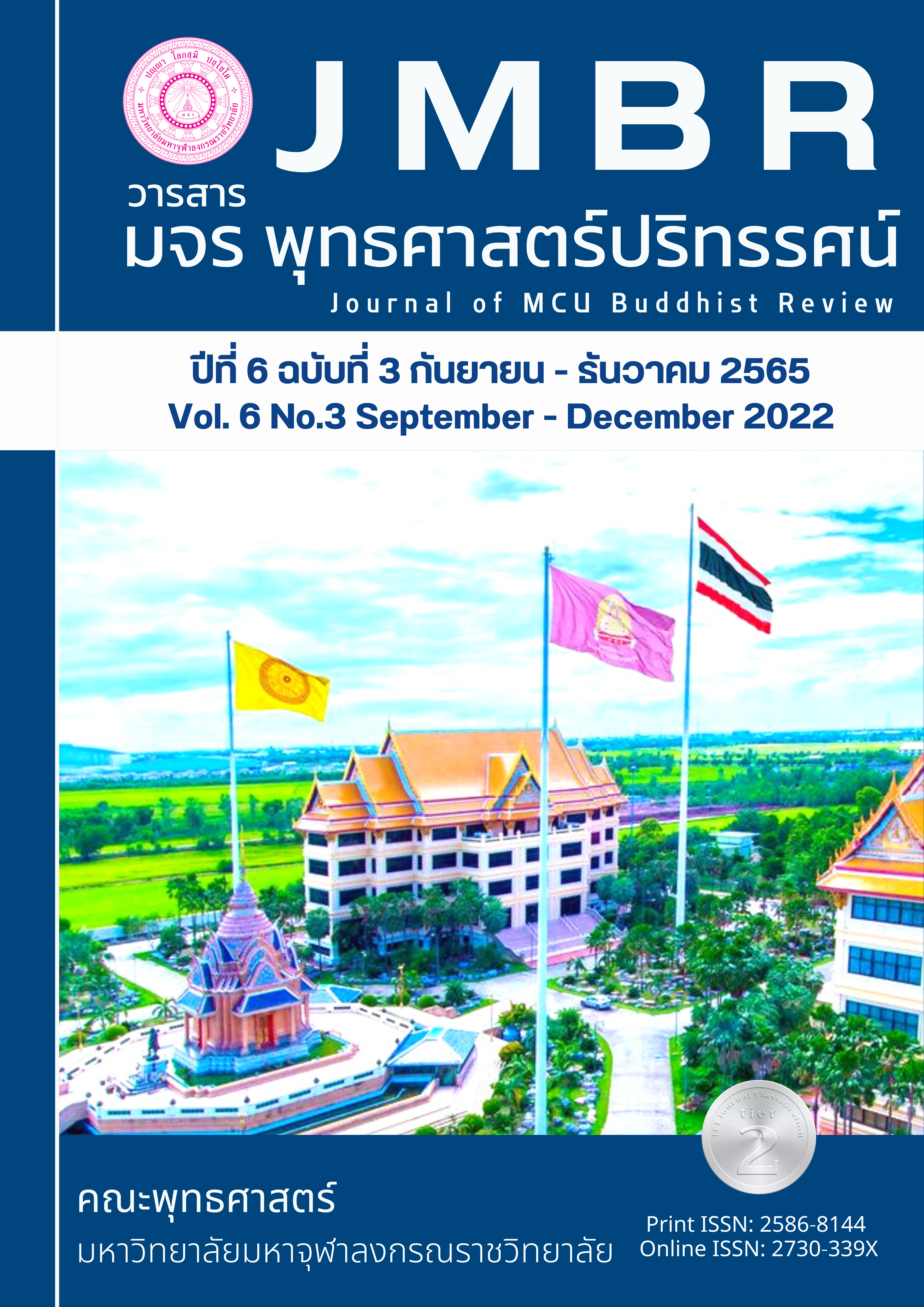การศึกษาเปรียบเทียบวิถีชีวิตทางศาสนาในสังคมของชาวพุทธกับชาวมุสลิม : กรณีศึกษาชุมชนบ้านคลองบางตะเคียน ตำบลบางโฉลง อำเภอบางพลีจังหวัดสมุทรปราการ
Main Article Content
บทคัดย่อ
บทความนี้มีวัตถุประสงค์ 1) เพื่อศึกษาวิถีชีวิตทางศาสนาในสังคมของชาวพุทธในชุมชนบ้านคลองบางตะเคียน ตำบลบางโฉลง อำเภอบางพลี จังหวัดสมุทรปราการ 2) เพื่อศึกษาวิถีชีวิตทางศาสนาในสังคมของชาวมุสลิมในชุมชนบ้านคลองบางตะเคียน ตำบลบางโฉลง อำเภอบางพลี จังหวัดสมุทรปราการ 3) เพื่อเปรียบเทียบวิถีชีวิตทางศาสนาในสังคมของชาวพุทธและชาวมุสลิมในชุมชนบ้านคลองบางตะเคียน ตำบลบางโฉลง อำเภอบางพลี จังหวัดสมุทรปราการ งานวิจัยครั้งนี้เป็นการศึกษาเชิงคุณภาพ โดยศึกษาและรวบรวมข้อมูลจากคัมภีร์ทางศาสนา เอกสารงานวิจัยที่เกี่ยวข้อง และการสัมภาษณ์กลุ่มเป้าหมาย ผลการวิจัยพบว่า
วิถีปฏิบัติในพระพุทธศาสนาคือ ศีลธรรม จารีตประเพณี คำสั่งสอนในทางศาสนา ที่ศาสดาผู้ประกาศศาสนาได้นำมาเผยแผ่ สอนให้มนุษย์ได้ประพฤติตามทั้งข้อที่ควรและไม่ควรประพฤติตามคือ ข้อที่ทรงอนุญาตได้แก่ กุศลธรรมความดีและในข้อที่ทรงห้ามเช่น ศีล 5 เป็นต้น และอกุศลธรรมความชั่วต่าง ๆ ที่เกิดจากการกระทำทางกาย วาจา และทางใจ ส่วนวิถีปฏิบัติทางศาสนาในศาสนาอิสลาม คือ ปฏิบัติตนตามหลักการ 3 ประการ คือ 1) หลักการศรัทธา 2) หลักการปฏิบัติ และ 3) หลักคุณธรรมการศรัทธาในศาสนาอิสลาม และความศรัทธาของภายในหัวใจ ไม่มีใครมีอำนาจที่จะทำอะไรได้ นอกเหนือจากอัลลอฮฺ องค์เดียวเท่านั้น
วิถีชีวิตทางศาสนาของชาวพุทธในชุมชนบ้านคลองบางตะเคียน เน้นหลักการ ๓ ประการ คือ 1) การทำหน้าที่ของตนเองให้สมบูรณ์ รู้ว่าตนคือใคร ควรมีบทบาทอย่างไร 2) เข้าใจวิถีปฏิบัติทางศาสนาของผู้อื่น 3) สละประโยชน์ส่วนตัวเพื่อประโยชน์ส่วนรวม การเป็นผู้นำของชุมชน ต้องมีความเป็นผู้นำที่ทำจริง ทำให้เห็นเพื่อประโยชน์ต่อส่วนรวม ส่วนวิถีปฏิบัติทางศาสนาในทัศนะของชาวมุสลิมในชุมชนบ้านคลองบางตะเคียน จังหวัดสมุทรปราการ พบว่า การทำหน้าที่ของตนให้สมบูรณ์ เป็นการสร้างเหตุแห่งความสุข คือสงบ สันติ เบิกบานใจ ความสุขจะเกิดขึ้นได้ก็ต่อเมื่อเราได้ปฏิบัติตามความเชื่อของหลักการ
ชาวพุทธกับชาวมุสลิมที่อาศัยอยู่ในชุมชนบ้านคลองบางตะเคียนนั้น มีวิถีชีวิตอยู่อย่างสันติสุข ไร้ความขัดแย้งทางศาสนา มีความแตกต่างกันเพียงความศรัทธาในศาสนาของตน ไม่ก้าวล่วงวิถีปฏิบัติทางศาสนาของบุคคลอื่น ดังนั้น การรู้จักเอาใจเขามาใส่ใจเรา และการลงมือทำกิจกรรมร่วมกัน จึงเป็นการเชื่อมประสานให้มนุษย์เข้าใจซึ่งเหตุและผลของกันและกัน
Article Details

อนุญาตภายใต้เงื่อนไข Creative Commons Attribution-NonCommercial-NoDerivatives 4.0 International License.
- บทความที่ได้รับการตีพิมพ์เป็นลิขสิทธิ์ของวารสาร มจร พุทธศาสตร์ปริทรรศน์
- ข้อความใดๆ ที่ปรากฎในบทความที่ได้รับการตีพิมพ์ในวารสาร ถือเป็นความรับผิดชอบของผู้เขียนบทความ และข้อคิดเห็นนั้นไม่ถือว่าเป็นทัศนะและความรับผิดชอบของกองบรรณาธิการวารสาร มจร พุทธศาสตร์ปริทรรศน์
เอกสารอ้างอิง
ธเนศ นกเพ็ชร. (2565). วิถีชีวิตใหม่ภายใต้พระพุทธศาสนา. วารสารมหาจุฬานาครทรรศน์. 9(1) มกราคม, 292-302.
พระสุธีรัตนบัณฑิต, พระครูโสภณพุทธศาสตร์. (2559). อัตลักษณ์ทางศาสนา: รูปแบบการสื่อความหมายเพื่อสร้างสันติภาพของประชาคมอาเซียน. สถาบันวิจัยพุทธศาสตร์: มหาวิทยาลัยมหาจุฬาลงกรณราชวิทยาลัย.
มหาจุฬาลงกรณราชวิทยาลัย. (2539). พระไตรปิฎกภาษาไทย ฉบับมหาจุฬาลงกรณราชวิทยาลัย. กรุงเทพมหานคร: โรงพิมพ์มหาจุฬาลงกรณราชวิทยาลัย.
มัรวาน สะมะอุน. (2524). คัมภีร์อัลกุรอาน ฉบับแปลภาษาไทย. กรุงเทพมหานคร: สำนักพิมพ์ ส.วงศ์เสงี่ยม.
วิจิตร สมบัติบริบูรณ์. (2528). เบญจศีล–เบญจธรรม. กรุงเทพมหานคร: โรงพิมพ์ชวนพิมพ์.
สุไรยา วานิ, มะรอนิง สาแลมิง. (2557). การอยู่ร่วมกันของชุมชนในสังคมพหุวัฒนธรรม กรณีศึกษา ตำบลทรายขาว อำเภอโคกโพธิ์ จังหวัดปัตตานี. วารสารการเมืองการปกครอง. 4(1) ปีที่ 4 กันยายน, 217.
สมบูรณ์ วัฒนะ และคณะ. (2564). พระพุทธศาสนากับวิถีชีวิตคนไทยในดินแดนสุวรรณภูมิ. วารสารสันติศึกษาปริทรรศน์ มจร. 9(3) พฤษภาคม, 950-964.
อีสมาแอ กาเต๊ะ. (2560). วะสะฎียะฮฺในอิสลามกับการอยู่ร่วมกันท่ามกลางสังคมพหุวัฒนธรรมด้านความเชื่อและความคิด. วารสารวิทยาลัยอิสลามศึกษา มหาวิทยาลัยสงขลานครินทร์. 9(1)มกราคม – มิถุนายน, 48.


